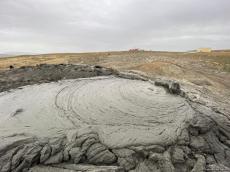|
|
TODAY.AZ / Society
Mud volcano erupts in outskirts of Azerbaijani capital [VIDEO]
11 August 2022 [16:51] - TODAY.AZ

By Azernews
By Laman Ismayilova
A mud volcano has erupted in Baku's Garadagh District, Azernews reports. The eruption occurred on the territory of Lokbatan settlement.
Speaking about the volcano eruption, a spokesperson for the Biodiversity Protection Service Arzu Babayeva said that no settlements are located near Lokbatan mud volcano.
The Ministry of Ecology and Natural Resources is currently monitoring the Lokbatan mud volcano that previously erupted in 2017.
Lokbatan mud volcano is located on the oilfield site of the same name on the coast of the Caspian sea, 15 kilometers southwest of Baku.
It's one of the five most active mud volcanoes in the world. Since 1810, the volcano has erupted 25 times.
In 1933, geologists discovered large reserves of oil and gas in the region after drilling a well at the foot of the volcano. It was due to this fact that the theory about the direct connection of mud volcanoes with hydrocarbon deposits subsequently appeared.
Azerbaijan is home to some stunning and unique natural wonders. The Land of Fire has the most significant number of mud volcanoes worldwide.
At present, there are 365 mud volcanoes in Azerbaijan. Most volcanoes are active, and 43 of them are protected by the Azerbaijan Ministry of Ecology and Natural Resources.
For security reasons, the admission of people is prohibited.
Until the end of 2019, Azerbaijani scientists expect several volcanic eruptions, including Bozdag-Gobu volcanoes in Absheron district, Bahar in Alat village, and Shikhzahirli volcano in Gobustan.
Tourists can get a unique panoramic view of the spectacular natural wonder in the Gobustan State Historical-Artistic Reserve.
The world’s largest mud volcanoes - Boyuk Khanizadagh and Turaghai - are both in Azerbaijan. Boyuk Khanizadagh erupted on October 10, 2001, shooting out flames for 300 meters in the air. It was the highest record for flames shot from a mud volcano.
NASA geologists studying Mars concluded that the mud volcanoes of Azerbaijan are similar to the uplands of the planet in their structure.
On September 5, 2004, the largest mud volcano in the territory of Azerbaijan was added to the Guinness World Records. Azerbaijan's rich fields of oil and gas condensate such as Lokbatan, Garadagh, Oil Rocks, and Mishovdag were also discovered near mud volcanoes.
The lava, mud, and liquid spewed by mud volcanoes are used as raw materials for chemical and construction industries, as well as pharmacology.
Enriched with specific components - mineral salts, organic substances, microelements, volcanic mud has medicinal properties that have a beneficial effect on the human body. Volcanic mud greatly affects the treatment of patients suffering from diseases of the peripheral and central nervous system, gastrointestinal tract, skin, etc.
URL: http://www.today.az/news/society/224047.html
 Print version
Print version
Connect with us. Get latest news and updates.
See Also
- 21 November 2025 [14:25]
Leyla Aliyeva, Arzu Aliyeva and Alena Aliyeva participate in environmental campaigns in Lankaran - 21 November 2025 [13:32]
Indonesia to host D-8 Forum in 2026–2027 - 21 November 2025 [13:29]
Azerbaijan highlights role of standards in green transition at COP30 - 21 November 2025 [12:58]
Azerbaijani, Chinese universities to establish joint medical working group - 21 November 2025 [11:37]
Armenian civil society delegation arrives in Baku for continued peace dialogue - 20 November 2025 [14:37]
National judo team joins training camp in Japan - 20 November 2025 [13:15]
National Art Museum to host lecture on Diego Rivera's art - 20 November 2025 [12:50]
Azerbaijan remains active in climate diplomacy after handing over COP Presidency to Brazil - 20 November 2025 [11:50]
Milli Majlis resumes review of key 2026 budget packages - 20 November 2025 [11:35]
US political affairs advisor honors fallen at Alley of Martyrs
Most Popular
 Victim testimonies heard as trial of Ruben Vardanyan continues in Baku Military Court
Victim testimonies heard as trial of Ruben Vardanyan continues in Baku Military Court
 Azerbaijan, US discuss progress on Middle Corridor and Zangazur Corridor
Azerbaijan, US discuss progress on Middle Corridor and Zangazur Corridor
 Baku hosts D-8 media forum bringing together global media leaders
Baku hosts D-8 media forum bringing together global media leaders
 Armenian civil society delegation arrives in Baku for continued peace dialogue
Armenian civil society delegation arrives in Baku for continued peace dialogue
 Azerbaijan highlights role of standards in green transition at COP30
Azerbaijan highlights role of standards in green transition at COP30
 Beloved UK dog breeds may vanish
Beloved UK dog breeds may vanish
 ADB reviewing major railway modernization project on Azerbaijan’s North–South Corridor
ADB reviewing major railway modernization project on Azerbaijan’s North–South Corridor
